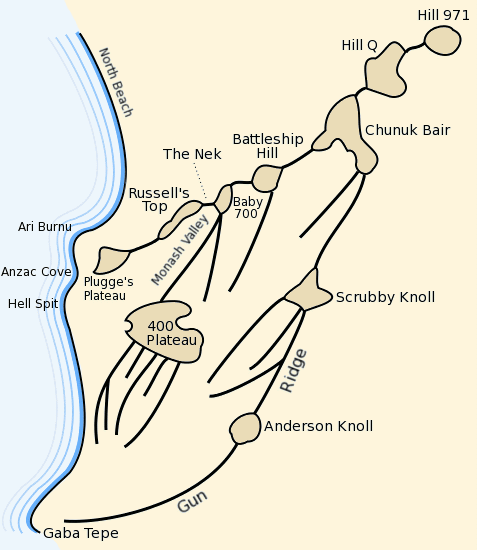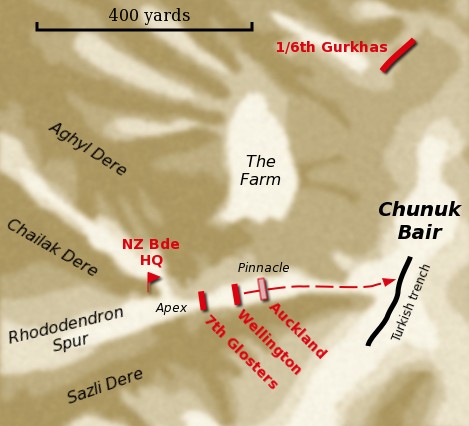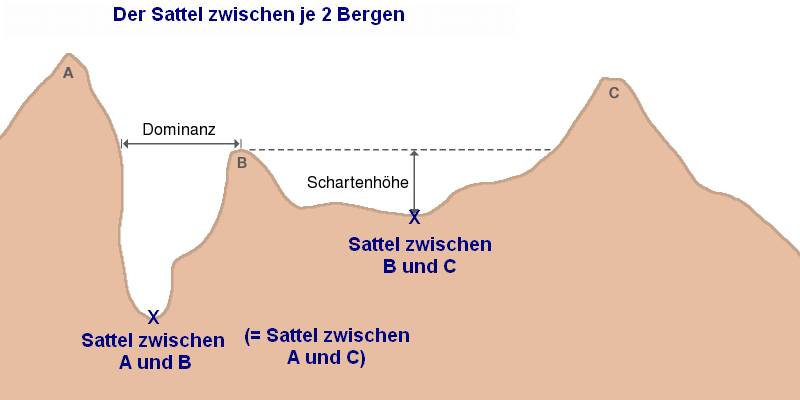|
Battle Of The Nek
The Battle of the Nek () was a minor battle that took place on 7 August 1915, during the Gallipoli campaign of World War I. "The Nek" was a narrow stretch of ridge on the Gallipoli Peninsula. The name derives from the Afrikaans word for a "mountain pass" but the terrain itself was a perfect bottleneck and easy to defend, as had been proven during an Ottoman Empire, Ottoman attack in June. It connected Australian and New Zealand trenches on the ridge known as "Russell's Top" to the knoll called "Baby 700" on which the Ottoman defenders were entrenched. The campaign on the Gallipoli Peninsula had begun in April 1915, but over the following months had developed into a stalemate. In an effort to break the deadlock, the British and their allies launched an offensive to Battle of Sari Bair, capture the Sari Bair range. As part of this effort, a feint attack by Australian troops was planned at the Nek to support New Zealand troops assaulting Battle of Chunuk Bair, Chunuk Bair. Early on ... [...More Info...] [...Related Items...] OR: [Wikipedia] [Google] [Baidu] |
George Washington Lambert
George Washington Thomas Lambert (13 September 1873 – 29 May 1930) was an Australian artist, known principally for portrait painting and as a war artist during the First World War. Early life Lambert was born in St Petersburg, Russia, the Posthumous birth, posthumous son of George Washington Lambert (1833 – 25 July 1873, in London) of Baltimore, Maryland. The younger Lambert's mother was Annie Matilda, ''née'' Firth, an Englishwoman. Mother and son soon moved to Württemberg, Germany, to be with Lambert's maternal grandfather. Lambert was educated at Kingston College, Yeovil, Somerset. The family, consisting of Lambert, his mother and three sisters, decided to emigrate to Australia. They arrived in Sydney aboard the ''Bengal'' on 20 January 1887. Career Lambert began exhibiting his pictures at the Art Society and the Society of Artists, Sydney in 1894. Lambert began contributing pen-and-ink cartoons for ''The Bulletin (Australian periodical), The Bulletin'' in 18 ... [...More Info...] [...Related Items...] OR: [Wikipedia] [Google] [Baidu] |
Battle Of Chunuk Bair
The Battle of Chunuk Bair () was a World War I battle fought between the Ottoman defenders and troops of the British Empire over control of the peak in August 1915. The capture of Chunuk Bair, ( Basin Slope, now ''Conk Bayırı''), the secondary peak of the Sari Bair range, was one of the two objectives of the Battle of Sari Bair. British units that reached the summit of Chunuk Bair early on 8 August 1915 to engage the Turks were the Wellington Battalion of the New Zealand and Australian Division, 7th (Service) Battalion, Gloucestershire Regiment; and 8th (Service) Battalion, Welch Regiment, both of the 13th (Western) Division. The troops were reinforced in the afternoon by two squads of the Auckland Mounted Rifles Regiment, also part of the New Zealand and Australian Division. The first troops on the summit were severely depleted by Ottoman return fire and were relieved at 10:30pm on 8 August by the Otago Battalion (NZ), and the Wellington Mounted Rifles Regiment, New Ze ... [...More Info...] [...Related Items...] OR: [Wikipedia] [Google] [Baidu] |
Auckland Mounted Rifles Regiment
The Auckland Mounted Rifles Regiment was a mounted infantry regiment from New Zealand raised, in August 1914, for service during the First World War. It was assigned to the New Zealand Mounted Rifles Brigade, part of the New Zealand Expeditionary Force. The regiment was established with twenty-six officers, 523 other ranks (UK), other ranks and 600 horses. It was formed from three squadron (army), squadrons belonging to pre war Territorial Force (NZ), Territorial Force regiments: the 3rd (Auckland) Mounted Rifles, the 4th (Waikato) Mounted Rifles and the 11th (North Auckland) Mounted Rifles. It included a small headquarters and, until 1916, a Maxim gun, Maxim machine-gun section. During the war, the Maxim guns were withdrawn but the regiment's fire-power increased until each squadron had four Hotchkiss M1909 Benet–Mercie machine gun, Hotchkiss machine-guns, one per troop, by the end of the war. As mounted infantry, the regiment rode into battle on their horses but were expec ... [...More Info...] [...Related Items...] OR: [Wikipedia] [Google] [Baidu] |
Wellington Mounted Rifles Regiment
The Wellington Mounted Rifles Regiment was a mounted infantry regiment from New Zealand, raised for service during the First World War. It was assigned to the New Zealand Mounted Rifles Brigade, part of the New Zealand Expeditionary Force. The regiment, with an establishment of twenty-six officers, 523 other ranks and 600 horses, was formed from three squadrons belonging to pre war Territorial Force regiments; the Queen Alexandra's 2nd (Wellington West Coast) Mounted Rifles, the 6th (Manawatu) Mounted Rifles and the 9th (Wellington East Coast) Mounted Rifles. It also included a small headquarters and, until 1916, a Maxim machine-gun section. The Maxim guns were withdrawn but the regiment's fire-power increased during the war, by the end of which each squadron had four Hotchkiss machine-guns, one per troop. As mounted infantry, the regiment rode into battle on their horses, but were expected to dismount for battle, and then fight on foot. The regiment fought predominant ... [...More Info...] [...Related Items...] OR: [Wikipedia] [Google] [Baidu] |
Andrew Hamilton Russell
Major General Sir Andrew Hamilton Russell (23 February 1868 – 29 November 1960) was a senior officer of the New Zealand Military Forces who served during the First World War. Born in Napier, New Zealand, Russell spent most of his youth in England. He joined the British Army in 1888 and served in India before transferring to the Indian Army in pursuit of a more active life. He grew disillusioned with his career and resigned his commission in 1892 to become a farmer in New Zealand. Running a sheep farm on land owned by his father, he retained an interest in soldiering and helped raise a local militia unit before becoming a senior officer in the New Zealand Territorial Force. Appointed to command the New Zealand Mounted Rifles Brigade upon the outbreak of war, he rose swiftly to high command during the Gallipoli campaign and in December 1915 became commander of the New Zealand and Australian Division. He oversaw the evacuation of the Australian and New Zealand Army Corps from ... [...More Info...] [...Related Items...] OR: [Wikipedia] [Google] [Baidu] |
New Zealand Mounted Rifles Brigade
The New Zealand Mounted Rifles Brigade was a brigade of the New Zealand Army during the First World War. Raised in 1914 as part of the New Zealand Expeditionary Force, it was one of the first New Zealand units to sail for service overseas. The brigade was formed from three regiments – the Auckland Mounted Rifles, the Canterbury Mounted Rifles, the Wellington Mounted Rifles – and smaller support units. Altogether the brigade had an establishment of 1,940 men and 2,032 horses and by the end of the war over 17,700 men had served in the brigade. However, the entire brigade's dismounted rifle strength was the equivalent of only a battalion of infantry. By the end of 1914, the brigade had arrived in British Egypt and was assigned to the New Zealand and Australian Division. Its first active service was, in a dismounted role, during the Gallipoli Campaign, where they fought against the forces of the Ottoman Turkish Empire. Seven months later, after the evacuation from Gall ... [...More Info...] [...Related Items...] OR: [Wikipedia] [Google] [Baidu] |
57th Regiment (Ottoman Empire)
57th Regiment or 57th Infantry Regiment may refer to: * 57th (West Middlesex) Regiment of Foot, a disestablished unit of the British Army * 57th Infantry Regiment (Philippine Commonwealth Army), a unit of the Philippine Commonwealth Army during the Second World War from 1941 to 1946 * 57th Infantry Regiment (United States), a unit of Philippine scouts serving under United States command during World War II * 57th Infantry Regiment (Ottoman Army), a unit of the Ottoman Army during WWI * 57th Line Infantry Regiment a unit of the French Army * 57th Field Artillery Regiment (2nd/10th Dragoons), RCA, a unit of the Canadian Army * 57th Infantry Regiment (United States), a unit of the US Army ; American Civil War ;;Union (North) Army * 57th Illinois Volunteer Infantry Regiment * 57th Indiana Infantry Regiment * 57th New York Volunteer Infantry * 57th Ohio Infantry * 57th Pennsylvania Infantry * 57th United States Colored Infantry ;;Confederate (Southern) Army * 57th Virginia In ... [...More Info...] [...Related Items...] OR: [Wikipedia] [Google] [Baidu] |
Anzac Plateaus And Ridges
The Australian and New Zealand Army Corps (ANZAC) was originally a First World War army corps of the British Empire under the command of the Mediterranean Expeditionary Force. It was formed in Egypt in December 1914, and operated during the Gallipoli campaign. General William Birdwood commanded the corps, which primarily consisted of troops from the First Australian Imperial Force and 1st New Zealand Expeditionary Force, although there were also British and Indian units attached at times throughout the campaign. The corps disbanded in 1916, following the Allied evacuation of the Gallipoli peninsula and the formation of I ANZAC Corps and II ANZAC Corps. The corps was re-established, briefly, in the Second World War during the Battle of Greece in 1941. The term 'ANZAC' has been used since for joint Australian–New Zealand units of different sizes. History Original formation and the Gallipoli disaster Plans for the formation began in November 1914 while the first contingent ... [...More Info...] [...Related Items...] OR: [Wikipedia] [Google] [Baidu] |
Australian And New Zealand Army Corps
The Australian and New Zealand Army Corps (ANZAC) was originally a First World War army corps of the British Empire under the command of the Mediterranean Expeditionary Force. It was formed in Egypt in December 1914, and operated during the Gallipoli campaign. General William Birdwood commanded the corps, which primarily consisted of troops from the First Australian Imperial Force and 1st New Zealand Expeditionary Force, although there were also British and Indian units attached at times throughout the campaign. The corps disbanded in 1916, following the Allied evacuation of the Gallipoli peninsula and the formation of I ANZAC Corps and II ANZAC Corps. The corps was re-established, briefly, in the Second World War during the Battle of Greece in 1941. The term 'ANZAC' has been used since for joint Australian–New Zealand units of different sizes. History Original formation and the Gallipoli disaster Plans for the formation began in November 1914 while the first cont ... [...More Info...] [...Related Items...] OR: [Wikipedia] [Google] [Baidu] |
Plateau
In geology and physical geography, a plateau (; ; : plateaus or plateaux), also called a high plain or a tableland, is an area of a highland consisting of flat terrain that is raised sharply above the surrounding area on at least one side. Often one or more sides have deep hills or escarpments. Plateaus can be formed by a number of processes, including upwelling of volcanic magma, extrusion of lava, and erosion by water and glaciers. Plateaus are classified according to their surrounding environment as intermontane, piedmont, or continental. A few plateaus may have a small flat top while others have wider ones. Formation Plateaus can be formed by a number of processes, including upwelling of volcanic magma, extrusion of lava, plate tectonics movements, and erosion by water and glaciers. Volcanic Volcanic plateaus are produced by volcanic activity. They may be formed by upwelling of volcanic magma or extrusion of lava. The underlining mechanism in forming p ... [...More Info...] [...Related Items...] OR: [Wikipedia] [Google] [Baidu] |
Saddle (landform)
The saddle between two hills or mountains is the region surrounding the saddle point, the lowest point on the line tracing the drainage divide (the col) connecting the peaks. When, and if, the saddle is navigable, even if only on foot, the saddle of a (optimal) mountain pass, pass between the two massifs, is the area generally found around the lowest route on which one could pass between the two summits, which includes that point which is a mathematically when graphed a Maxima and minima, relative high along one axis, and a Maxima and minima, relative low in the perpendicular axis, simultaneously; that point being by definition the col of the saddle. Topography A saddle is the lowest area between two highlands (prominences or peaks) which has two wings which span the divide (the line between the two prominences) by crossing the divide at an angle, and, so is concurrently the local highpoint of the land surface which falls off in the lower direction. That is, the drainage divide ... [...More Info...] [...Related Items...] OR: [Wikipedia] [Google] [Baidu] |









